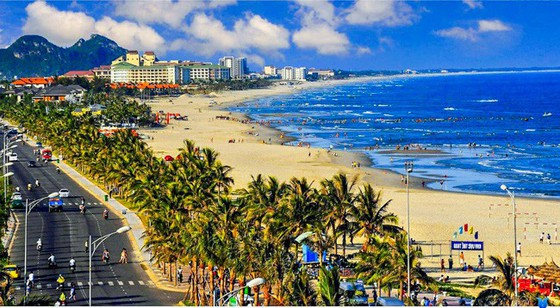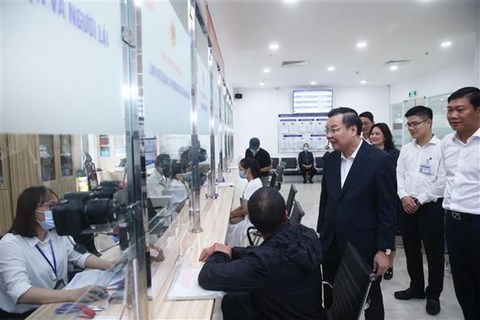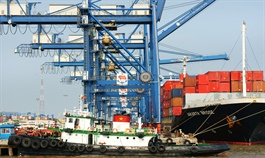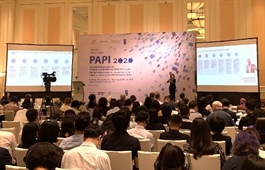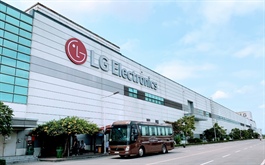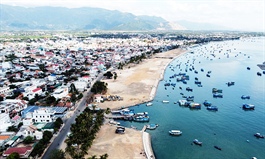Special Economic Zones create more risks than benefits
Special Economic Zones create more risks than benefits
Ho Chi Minh City and Da Nang are seriously planning to convert the two cities into international financial centers. This decision has been raising much concern among experts in the field.
Vietnam should take advantage of its beautiful coastline in choosing SEZ model.
|
Future development
In order to create an international financial center with modern high-rise buildings in city centers or coastal areas requires substantial amounts of money. With much support of the central government, the two cities could possibly succeed in creating international financial centers to equal those in other regions of ASEAN, but doubts remain whether all the satisfactory prerequisites will be met.
This very ambitious plan is actually quite contradictory to Vietnam's aim of becoming a strong and prosperous nation, with a developed and high-income economy through use of high technology and innovation, as set forth in the Resolution adopted at the 13th National Congress of the Communist Party of Vietnam, early this year.
According to the Global Financial Center Index, as far as fintech application is concerned, New York tops the list, followed by Shanghai, Beijing, Shenzhen, then London. Ho Chi Minh City, as the country’s future international financial center, harbors an ultimate goal and aims to focus on the fintech sector, which will then drive the development process of the City.
Currently, under the ongoing pandemic scenario, new issues are reshaping the global financial world to prepare for a post-pandemic society, with the growth of artificial intelligence (AI) and substantial geopolitical changes. Various unforeseen issues are seriously shaking the Dubai international financial center, as also raising big questions about the future of Hong Kong as a global financial center, while Brexit may well mark the end of London as another international financial center. Therefore, taking the chance to becoming a leading international financial center is well worth targeting for Vietnam as this goal is not entirely out of reach because Asia controls six of the top ten international financial centers in the world.
With the world in upheaval, there are questions as to whether by means of appropriate policies and adequate support from the central government if Ho Chi Minh City or Da Nang City could be turned into major international financial centers. This issue has been high on the agenda at meetings with Ho Chi Minh City officials, scientists and central agency officals for the last several years.
Many have agreed to making this plan of becoming an international financial center even better than any other international financial center, and to becoming a new-generation special economic zone (SEZ). With international standard regulations and services in place and a high level of free flow of capital, an SEZ is possible, just like the ones in China, India and the United Arab Emirates.
Catastrophic losses
Generally speaking, SEZ is a separate territory within a country with more favorable support in terms of taxes and other regulations than other areas of the country. However, although a SEZ may bring immense benefits, it may also cause many problems. Firstly, it takes five to ten years to create large-scale benefits, and a SEZ will only be successful in attracting new investors if incentives and support are really appealing in comparison to other international SEZs. Since investors are not bound, they may leave instantly if benefits are not as expected. Consequently, bigger offers can also lead to bigger losses.
Secondly, fiscal incentives only attract investors who are interested in tax havens and can create white elephants that need staggering costs and require large amounts of money, but which owners cannot dispose of. A SEZ indicates a failure of investments by the state, and the bigger the investments, the more catastrophic are the losses. Thirdly, companies in a SEZ only want their products to have significant effect on commercial and investment activities in international markets while their expected impact on businesses of the host country could be devastatingly disappointing.
SEZs in China
It is necessary to analyze SEZs in China compared to other countries, so as to understand them better. The scale of the SEZs in China are just the opposite of SEZs in other countries. SEZs in the rest of the world are like pyramids, starting at a point on the top and getting bigger over time, but the SEZs in China began over a large area of 327 square kilometers, and then became smaller and smaller after 2003.
The first stage from 1980 to 1991, was meant for establishing and exploring, with SEZs playing a role in attracting FDIs and testing policies. The second stage from 1992 to1999 saw the strongest growth of SEZs along the coast, with at least one SEZ in each province. The third stage from 2000 to 2007 was intended for SEZs to expand further to the Central and Western regions and less developed areas. However, SEZs in the fourth stage from 2008 saw major changes with no more tax incentives for FDI businesses inside and outside SEZs. The new tax policy was applied to the whole economy, with improvements planned for other economic zones. SEZs of the fourth generation were not meant to test the policies like those of the first generation. Instead, they concentrated on development of high technologies to increase the global value chain, as well as attract the world intellectual elite.
The World Bank SEZ researchers have considered vast separate areas in China as typical of seeing SEZs as laboratories for testing policies on finance, labor and even pricing policy, and then applying them to the entire country for checking their effectiveness. However, this was useful for only the first SEZs like the ones in Shenzhen, Zhuhai, Shantou and Xiamen. These are places for testing the policies by assigning tasks with specific intentions since Shenzhen is next to Hong Kong, Zhuhai is near Macau and Xiamen is across from Taiwan. Choosing geographic locations for the first generation SEZs was the most important factor. The second generation SEZs in the 1990s were no longer meant for testing policies, but focused on the development of strategic regions. The third generation SEZs did not regard geographic locations as top priority, rather, they were expected to improve specific situations such as connection between rural and urban areas or ties of socio political and cultural centers in regions.
However, countries that try to learn from China model of SEZ are advised to consider its first generation SEZs with the main focus on choosing coastal areas. African countries like Egypt, Ethiopia and Zambia have been skeptical, even as China persuades them to follow in its footsteps. Development of SEZs is always hard, uncertain and only meant for brave and enterprising individuals.
Comprehensive review
The official method of SEZ impact assessment is based on the international trade model of static effect, including job creation, FDI attraction, foreign currency attraction and added economic value. The formal approach sees the SEZ only as the second-best policy option, behind entire liberalization of the economy. The more modern approach, by contrast, sees SEZ as a catalyst for overall growth in the economy as a whole which is the dynamic effect.
Recently, the dynamic effect approach has dominated the research of SEZ. Based on the theory of endogenous growth and the new institutional theory, the dynamic approach sees the spill-over effect and the benefits of the SEZ beyond the barrier of an independent oasis through backward linkage with domestic firms, human capital development, technological innovation, and institutional reform in the host country. While China's overall growth rate is still high, in the mid-2000s the growth rate of all SEZs was more or less stable, or even lower than the overall growth rate and ultimately converging into national growth. Only high-tech SEZs have outperformed the rest of the SEZs.
Lack of understanding
Asian countries also see SEZ as an institutional laboratory. The problem is that once these experiences are applied to the whole country, SEZ will gradually lose its role. SEZs one percent export growth contributes to an increase of 0.44% of GDP, but decreases gradually with the rate of economic liberalization. SEZ established in the 70s and 80s does not contribute much to job creation, exports, and growth in the present period. The room for SEZ to be successful in the future is decreasing and is only suitable for ideas of SEZ as venture capital. SEZ is only an option when the profitability is large enough to compensate for the loss in the event of SEZ failure. The core cause of SEZ failure in the world is due to lack of understanding.
There is no universal success formula for SEZ, and it is not like looking for coastal zones to establish an SEZ for it to be successful. The most typical failure of site selection is in the case of SEZ Calabar in the South East Nigerian Sea. SEZ Calabar failed due to site selection with a strong propensity to calculate the economic impact only in the static state, without paying attention to the connectivity of SEZ with major maritime routes and with medium national shipping centers, called the animation effect. The cause of the failure is also due to the fact that the central and local authorities always had conflict of interests, as well as extreme government intervention in the operation of SEZ Calabar.
Many countries establish the SEZ with a portfolio of industries such as hot pot for investors, including world-class universities with high-tech parks, manufacturing zones, and casinos as well. With the current mushroom-growing SEZ syndrome, in order to succeed, countries need to create a 21st century SEZ with a development mindset that is completely isolated from the achievements of the previous century. SEZ must not only become a common bloc for the economy but also have to go global. To do so, the South Korean government since early 2013 announced plans to establish the mini-SEZ system, replacing the popular 20th century thinking of setting up SEZs over a large area and isolated from the provinces and a big city. The majority of SEZs in India are also mini-SEZs.
Sovereignty at risk
Poor government administration leading to excessive national debt is one of the reasons for the SEZ cult. Creating SEZs with increasing budget revenues to try and cure a disease is actually curing only the symptoms. Establishing the SEZ only proves a choice of failure, and indicates the ascendancy of crony capitalism. The Sri Lankan government ceding the strategic port of Hambantota to China to write off a debt of USD 1.12 bn is called swapped sovereignty. Converting debt into shares is a dangerous debt-trap diplomacy tactic that China has applied to host countries dating back to the 1980s in export processing zone near the Costa Rican city of San José. Chinese SEZ developers’ buyback sovereign debt or government bonds at a discount price from a third party. They then negotiate with the Central Bank for debt relief, and in return, they get a good address in the SEZ.
Today Sri Lanka, Costa Rica, Greece, Venezuela, and Zimbabwe are typical cases of swap sovereignty debt in SEZs. In addition, the high land price in SEZ is one of the main reasons why the government and investors are very fond of SEZ. For example, in a fishing village, land prices for SEZ Shenzhen increased by nearly 5,000 percent over 30 years. SEZ developers who accept high risks with excess profit will offer world-class SEZ development plans, the first step to conquer the confidence of the host country, but then there is the sovereign debt swap game later.
In short, if you want to know how deformed an economy really is, then just look at the SEZ. Instead of a country defining SEZ, know how the SEZ defines the country, its purpose and for whom it is for, and what the current World Geopolitical Bureau has to do with the SEZ. It should be noted that SEZ tendency is only for political purposes and more of a gamble, and the country that does not need a special economic zone is truly unique and exceptional.


